engine TOYOTA SIENNA HYBRID 2021 Owners Manual (in English)
[x] Cancel search | Manufacturer: TOYOTA, Model Year: 2021, Model line: SIENNA HYBRID, Model: TOYOTA SIENNA HYBRID 2021Pages: 601, PDF Size: 32.07 MB
Page 4 of 601
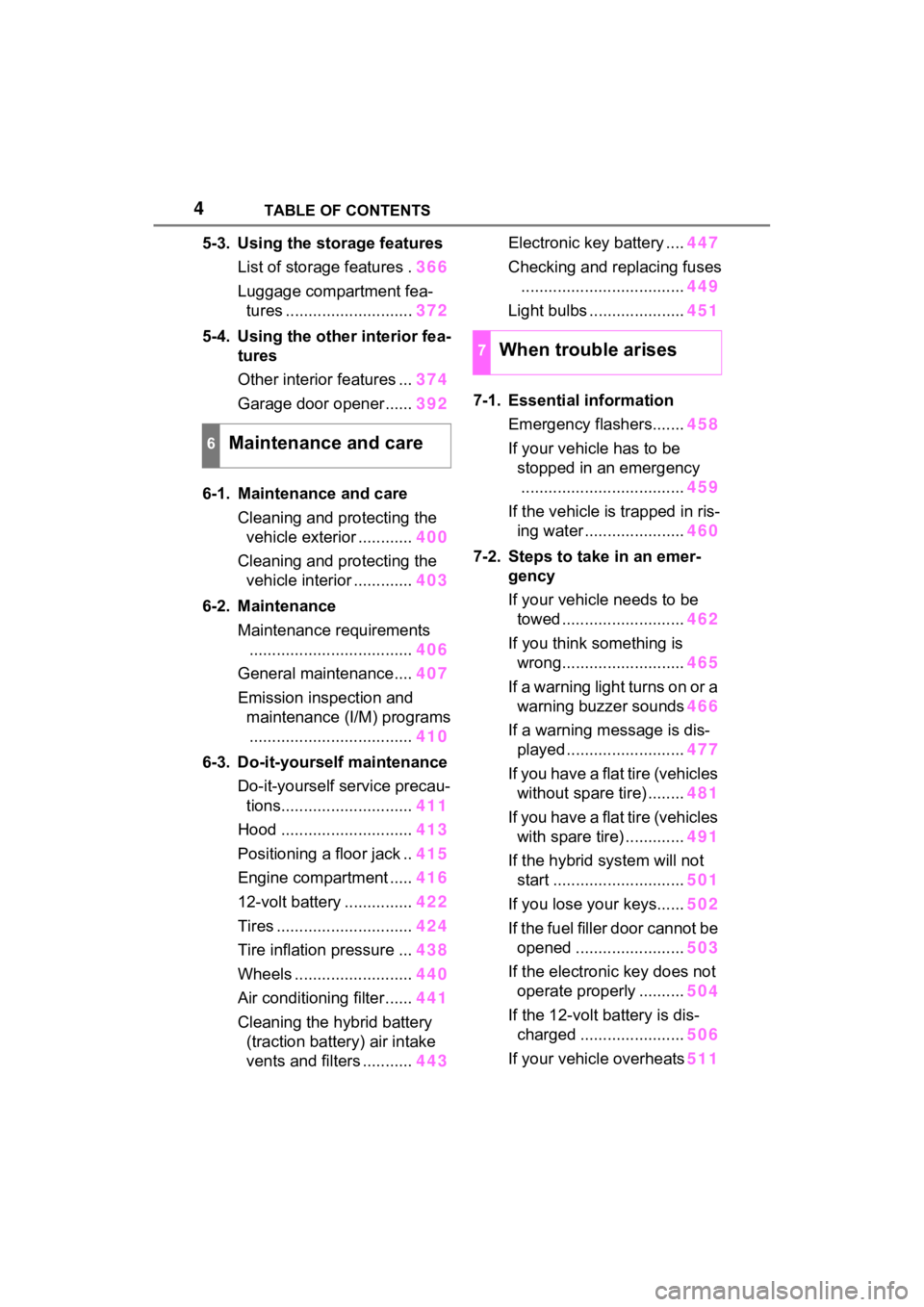
4TABLE OF CONTENTS
5-3. Using the storage featuresList of storage features . 366
Luggage compartment fea- tures ............................ 372
5-4. Using the other interior fea- tures
Other interior features ... 374
Garage door opener...... 392
6-1. Maintenance and care Cleaning and protecting the vehicle exterior ............ 400
Cleaning and protecting the vehicle interior ............. 403
6-2. Maintenance Maintenance requirements.................................... 406
General maintenance.... 407
Emission inspection and maintenance (I/M) programs.................................... 410
6-3. Do-it-yourself maintenance Do-it-yourself service precau-tions............................. 411
Hood ............................. 413
Positioning a floor jack .. 415
Engine compartment ..... 416
12-volt battery ............... 422
Tires .............................. 424
Tire inflation pressure ... 438
Wheels ......... .................440
Air conditioning filter ...... 441
Cleaning the hybrid battery (traction battery) air intake
vents and filters ........... 443Electronic key battery ....
447
Checking and replacing fuses .................................... 449
Light bulbs ..................... 451
7-1. Essential information Emergency flashers....... 458
If your vehicle has to be stopped in an emergency.................................... 459
If the vehicle is trapped in ris- ing water ...................... 460
7-2. Steps to take in an emer- gency
If your vehicle needs to be
towed ........................... 462
If you think something is wrong........................... 465
If a warning light turns on or a warning buzzer sounds 466
If a warning message is dis- played .......................... 477
If you have a flat tire (vehicles without spare tire) ........ 481
If you have a flat tire (vehicles with spare tire) ............. 491
If the hybrid system will not start ............................. 501
If you lose your keys...... 502
If the fuel filler door cannot be opened ......... ...............503
If the electronic key does not operate properly .......... 50
4
If the 12-
volt battery is dis-
charged ....................... 506
If your vehicle overheats 511
6Maintenance and care
7When trouble arises
Page 7 of 601
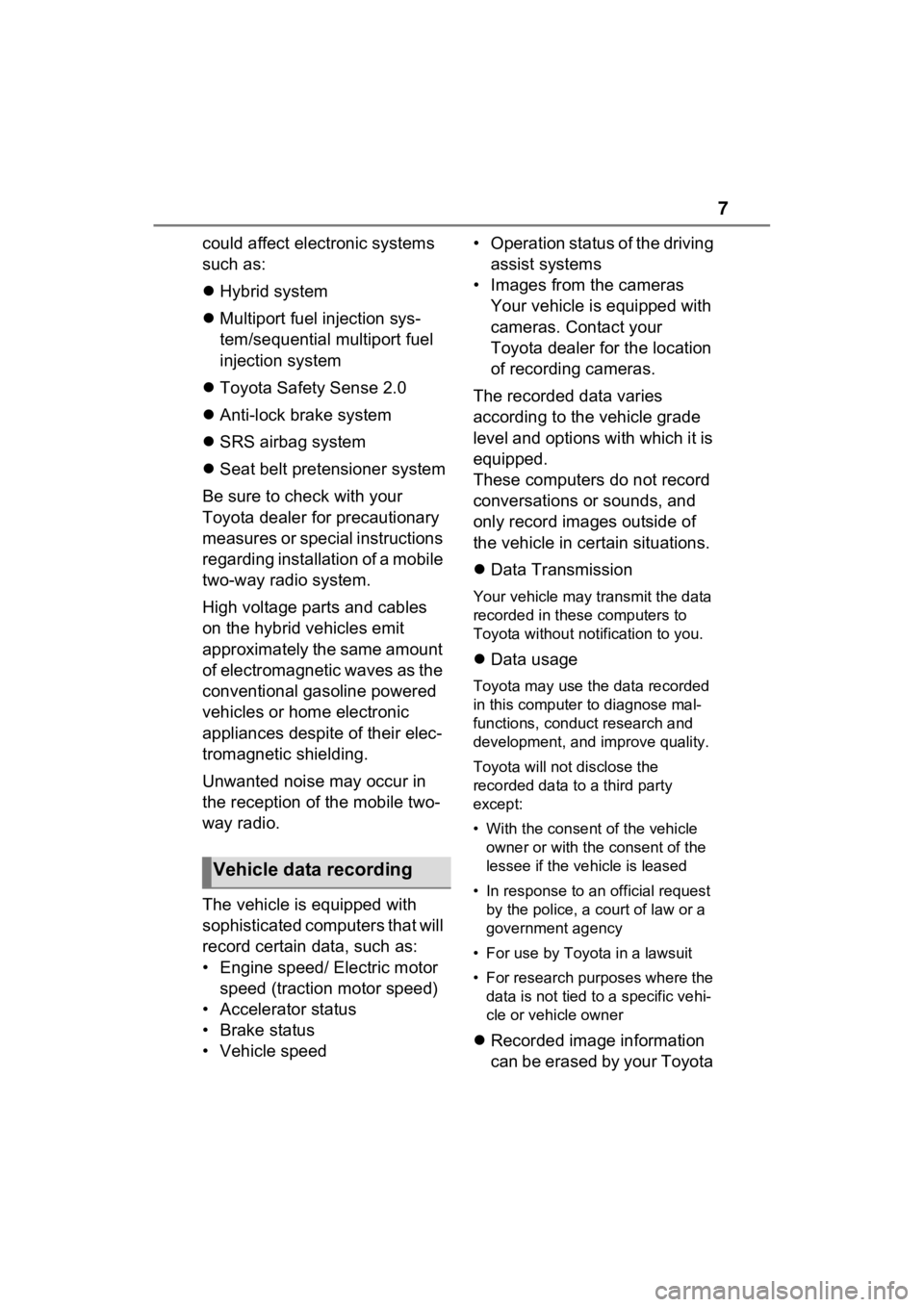
7
could affect electronic systems
such as:
Hybrid system
Multiport fuel injection sys-
tem/sequential multiport fuel
injection system
Toyota Safety Sense 2.0
Anti-lock brake system
SRS airbag system
Seat belt pretensioner system
Be sure to check with your
Toyota dealer for precautionary
measures or special instructions
regarding installation of a mobile
two-way radio system.
High voltage parts and cables
on the hybrid vehicles emit
approximately the same amount
of electromagnetic waves as the
conventional gasoline powered
vehicles or home electronic
appliances despite of their elec-
tromagnetic shielding.
Unwanted noise may occur in
the reception of the mobile two-
way radio.
The vehicle is equipped with
sophisticated computers that will
record certain data, such as:
• Engine speed/ Electric motor speed (traction motor speed)
• Accelerator status
• Brake status
• Vehicle speed • Operation status of the driving
assist systems
• Images from the cameras Your vehicle is equipped with
cameras. Contact your
Toyota dealer for the location
of recording cameras.
The recorded data varies
according to the vehicle grade
level and options with which it is
equipped.
These computers do not record
conversations or sounds, and
only record images outside of
the vehicle in certain situations.
Data Transmission
Your vehicle may transmit the data
recorded in these computers to
Toyota without notification to you.
Data usage
Toyota may use the data recorded
in this computer to diagnose mal-
functions, conduct research and
development, and improve quality.
Toyota will not disclose the
recorded data to a third party
except:
• With the consen t of the vehicle
owner or with the consent of the
lessee if the vehicle is leased
• In response to an official request by the police, a court of law or a
government agency
• For use by Toyota in a lawsuit
• For research purposes where the data is not tied to a specific vehi-
cle or vehicle owner
Recorded image information
can be erased by your Toyota
Vehicle data recording
Page 15 of 601
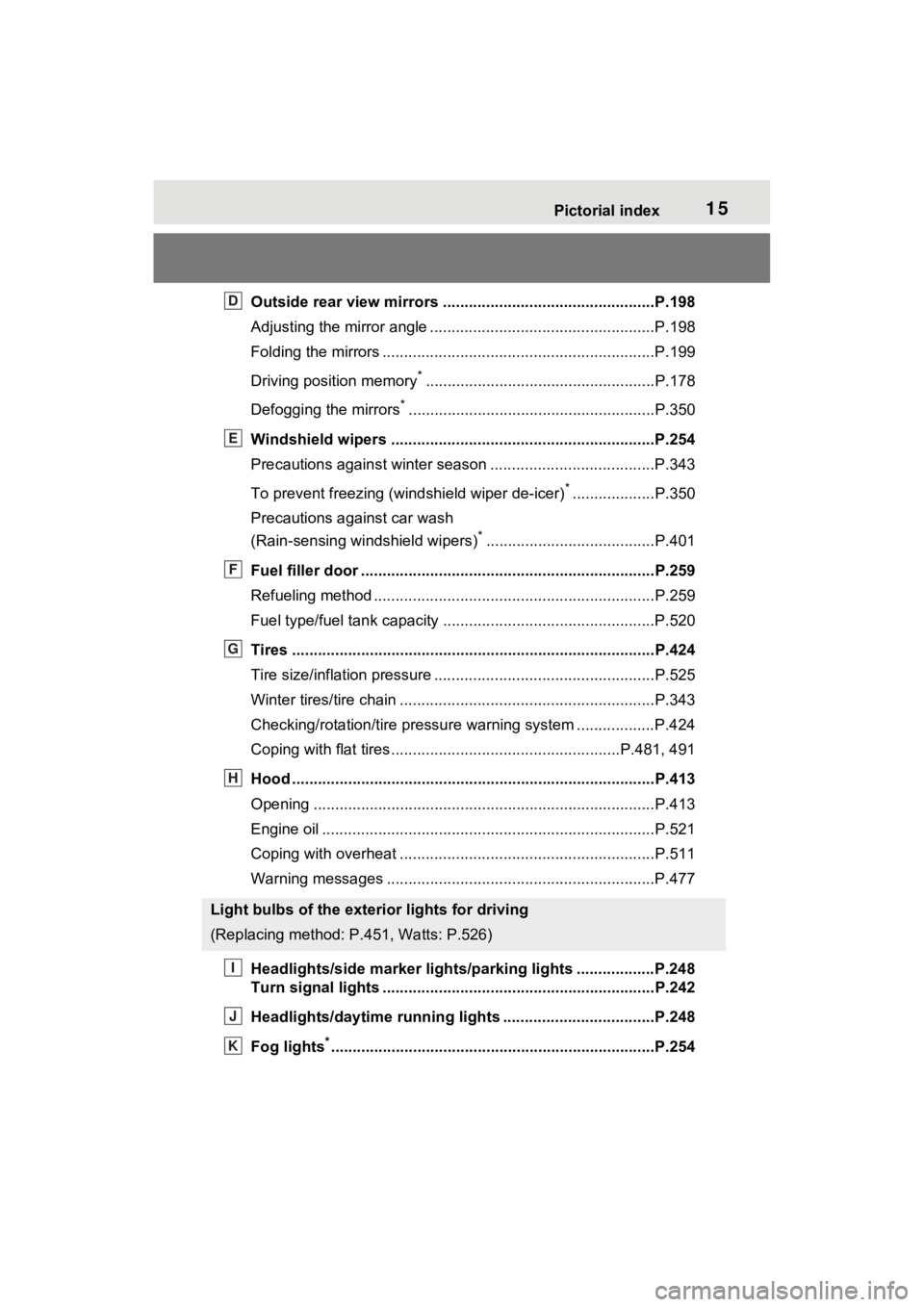
15Pictorial index
Outside rear view mirrors .................................................P.198
Adjusting the mirror angle ....................................................P.198
Folding the mirrors ...............................................................P.199
Driving position memory
*.....................................................P.178
Defogging the mirrors
*.........................................................P.350
Windshield wipers .............................................. ...............P.254
Precautions against winter season .............................. ........P.343
To prevent freezing (windshield wiper de-icer)
*...................P.350
Precautions against car wash
(Rain-sensing windshield wipers)
*.......................................P.401
Fuel filler door ............................................... .....................P.259
Refueling method ............................................... ..................P.259
Fuel type/fuel tan k capacity .................................................P.520
Tires ....................................................................................P.424
Tire size/inflation pressure ................................... ................P.525
Winter tires/tire chain ........................................ ...................P.343
Checking/rotation/tire pressur e warning system ..................P.424
Coping with flat tires......................................... ............P.481, 491
Hood ....................................................................................P.413
Opening ........................................................ .......................P.413
Engine oil ..................................................... ........................P.521
Coping with overheat ........................................... ................P.511
Warning messages ..............................................................P.477
Headlights/side marke r lights/parking lights ..................P.248
Turn signal lights ...............................................................P.242
Headlights/daytime running lights .............................. .....P.248
Fog lights
*............................................................... ............P.254
Light bulbs of the exterior lights for driving
(Replacing method: P.451, Watts: P.526)
D
E
F
G
H
I
J
K
Page 17 of 601
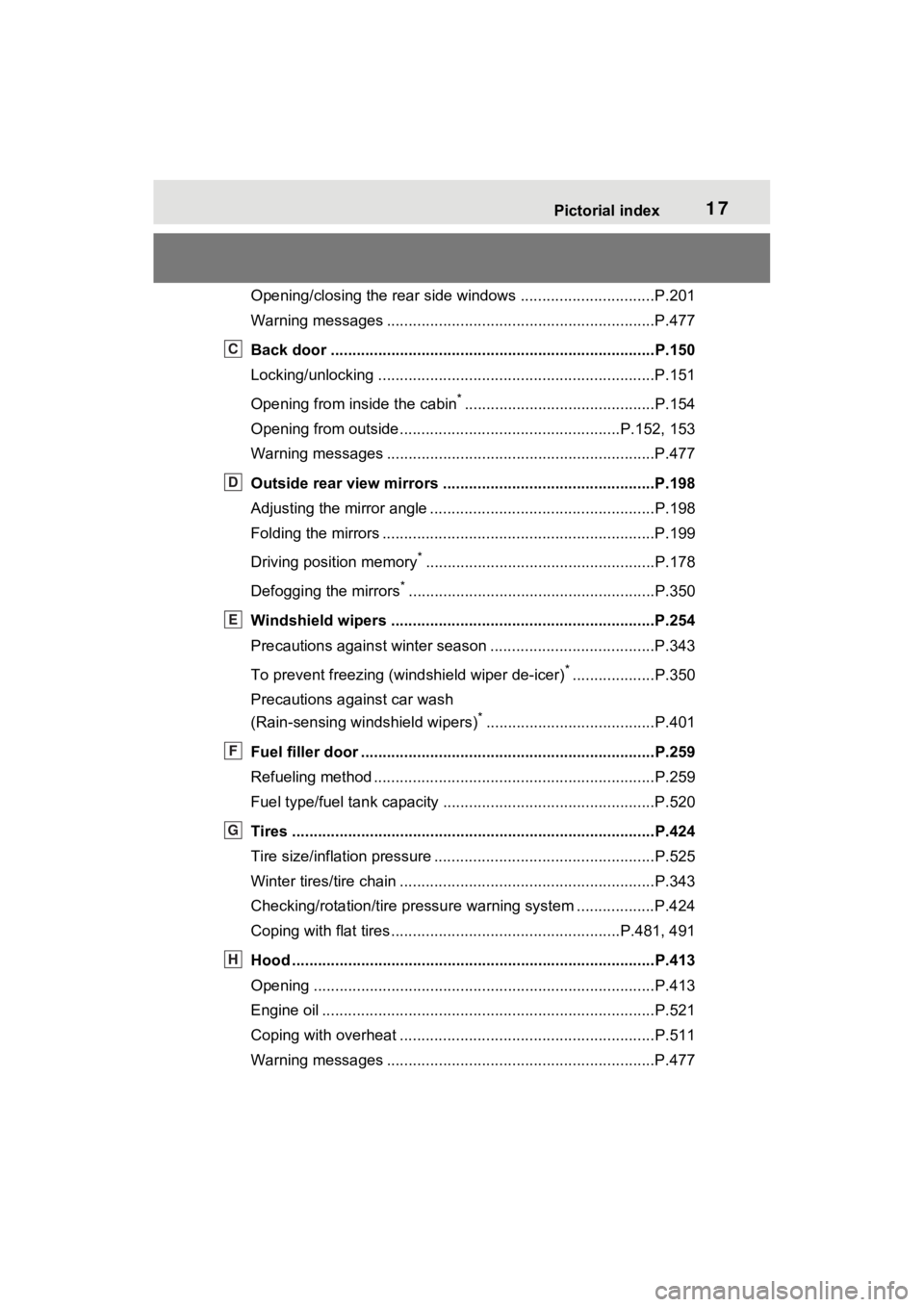
17Pictorial index
Opening/closing the rear side windows ...............................P.201
Warning messages ..............................................................P.477
Back door ...................................................... .....................P.150
Locking/unlocking ................................................................P.151
Opening from inside the cabin
*............................................P.154
Opening from outside........................................... ........P.152, 153
Warning messages ..............................................................P.477
Outside rear view mirrors .................................................P.198
Adjusting the mirror angle ..................................... ...............P.198
Folding the mirrors ...............................................................P.199
Driving position memory
*.....................................................P.178
Defogging the mirrors
*.........................................................P.350
Windshield wipers .............................................. ...............P.254
Precautions against winter season .............................. ........P.343
To prevent freezing (windshield wiper de-icer)
*...................P.350
Precautions against car wash
(Rain-sensing windshield wipers)
*.......................................P.401
Fuel filler door ............................................... .....................P.259
Refueling method ............................................... ..................P.259
Fuel type/fuel tan k capacity .................................................P.520
Tires ....................................................................................P.424
Tire size/inflation pressure ................................... ................P.525
Winter tires/tire chain ........................................ ...................P.343
Checking/rotation/tire pressur e warning system ..................P.424
Coping with flat tires......................................... ............P.481, 491
Hood ....................................................................................P.413
Opening ........................................................ .......................P.413
Engine oil ..................................................... ........................P.521
Coping with overheat ........................................... ................P.511
Warning messages ..............................................................P.477
C
D
E
F
G
H
Page 20 of 601
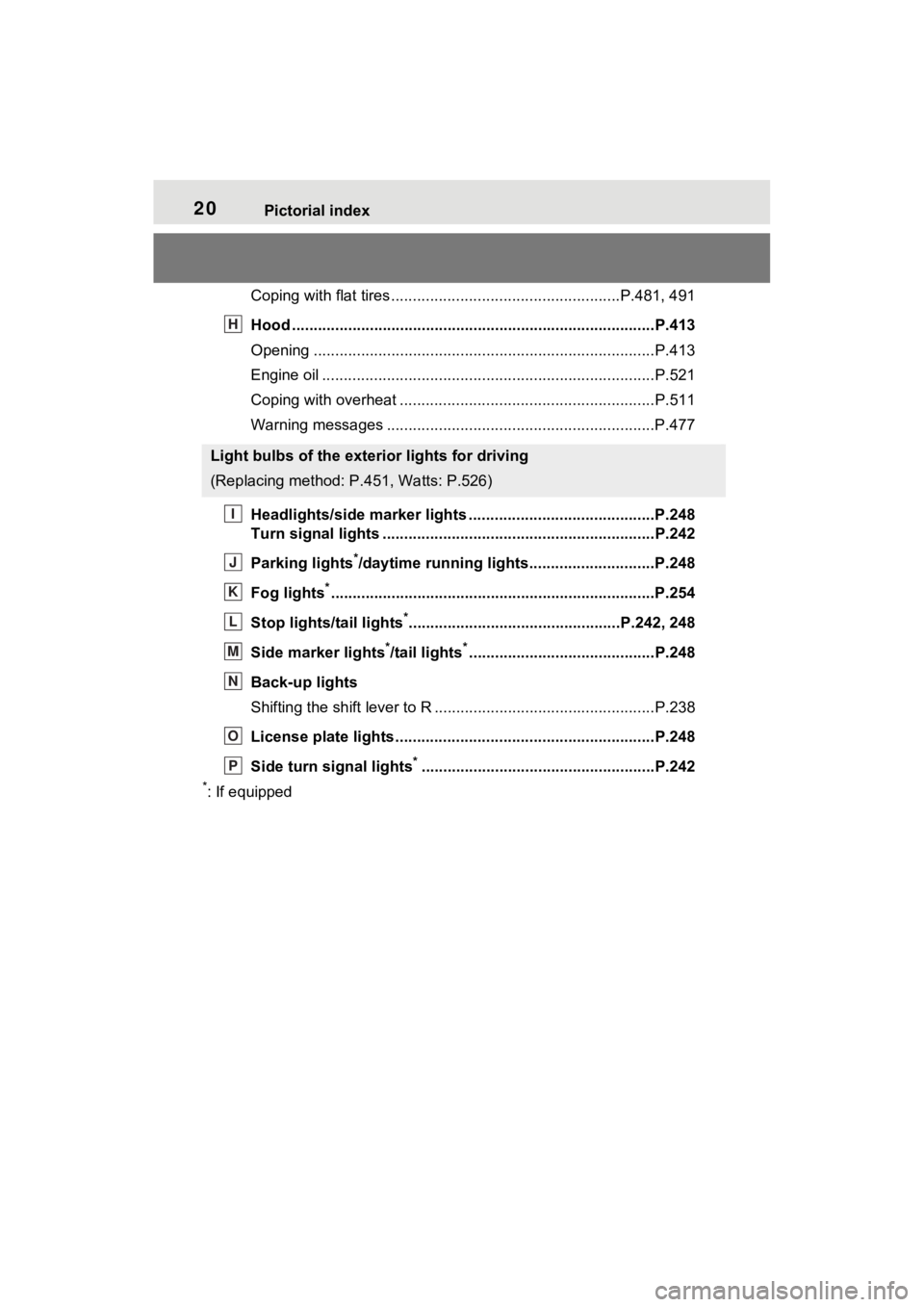
20Pictorial index
Coping with flat tires.....................................................P.481, 491
Hood ....................................................................................P.413
Opening ........................................................ .......................P.413
Engine oil ..................................................... ........................P.521
Coping with overheat ........................................... ................P.511
Warning messages ..............................................................P.477
Headlights/side marker lights .................................. .........P.248
Turn signal lights ...............................................................P.242
Parking lights
*/daytime running lights.............................P.248
Fog lights
*............................................................... ............P.254
Stop lights/tail lights
*.................................................P.242, 248
Side marker lights
*/tail lights*...........................................P.248
Back-up lights
Shifting the shift lever to R ...................................................P.238
License plate lights........................................... .................P.248
Side turn signal lights
*......................................................P.242
*: If equipped
Light bulbs of the exterior lights for driving
(Replacing method: P .451, Watts: P.526)
H
I
J
K
L
M
N
O
P
Page 43 of 601

431-1. For safe use
1
For safety and security
Side impact sensors (rear)
Driver’s seat belt buckle switch
Driver’s seat position sensor
Driver airbag
Front passenger occupant classification sensors
Driver’s knee airbag
SRS warning light
Airbag sensor assembly
Your vehicle is equipped with ADVANCED AIRBAGS designed
based on the US motor vehicle safety standards (FMVSS208). The
airbag sensor assembly (ECU) cont rols airbag deployment based on
information obtained from the sensors etc. shown in the system
components diagram above. This in formation includes crash sever-
ity and occupant information. As the airbags deploy, a chemical
reaction in the inflators quickly fills the airbags with non-toxic gas to
help restrain the motion of the occupants.
■If the SRS airbags deploy
(inflate)
●Slight abrasions, burns, bruising
etc., may be sustained from SRS
airbags, due to the extremely high
speed deployment (inflation) by
hot gases.
●A loud noise and white powder will
be emitted.
●Parts of the airbag module (steer-
ing wheel hub, airbag cover and
inflator) as well as the front seats,
parts of the front and rear pillars,
and roof side rails, may be hot for
several minutes. T he airbag itself
may also be hot.
●The windshield may crack.
●The hybrid system will be stopped
and fuel supply to the engine will
be stopped. ( P.86)
●All of the doors will be unlocked
( P.134)
●The brakes and st op lights will be
controlled automatically. (
P.336)
●The interior lights will turn on auto-
matically. ( P.365)
●The emergency flashers will turn
on automatically. ( P.458)
●For Safety Connect subscribers, if
any of the following situations
occur, the system is designed to
send an emergency call to the
response center, notifying them of
the vehicle’s location (without
needing to push the “SOS” button)
and an agent will attempt to speak
with the occupants to ascertain
the level of emergency and assis-
tance required. If the occupants
are unable to communicate, the
agent automatically treats the call
as an emergency and helps to dis-
patch the necessary emergency
services. ( P.75)
• An SRS airbag is deployed.
• A seat belt pretensioner is acti- vated.
• The vehicle is involved in a severe rear-end collision.
L
M
N
O
P
Q
R
S
Page 78 of 601
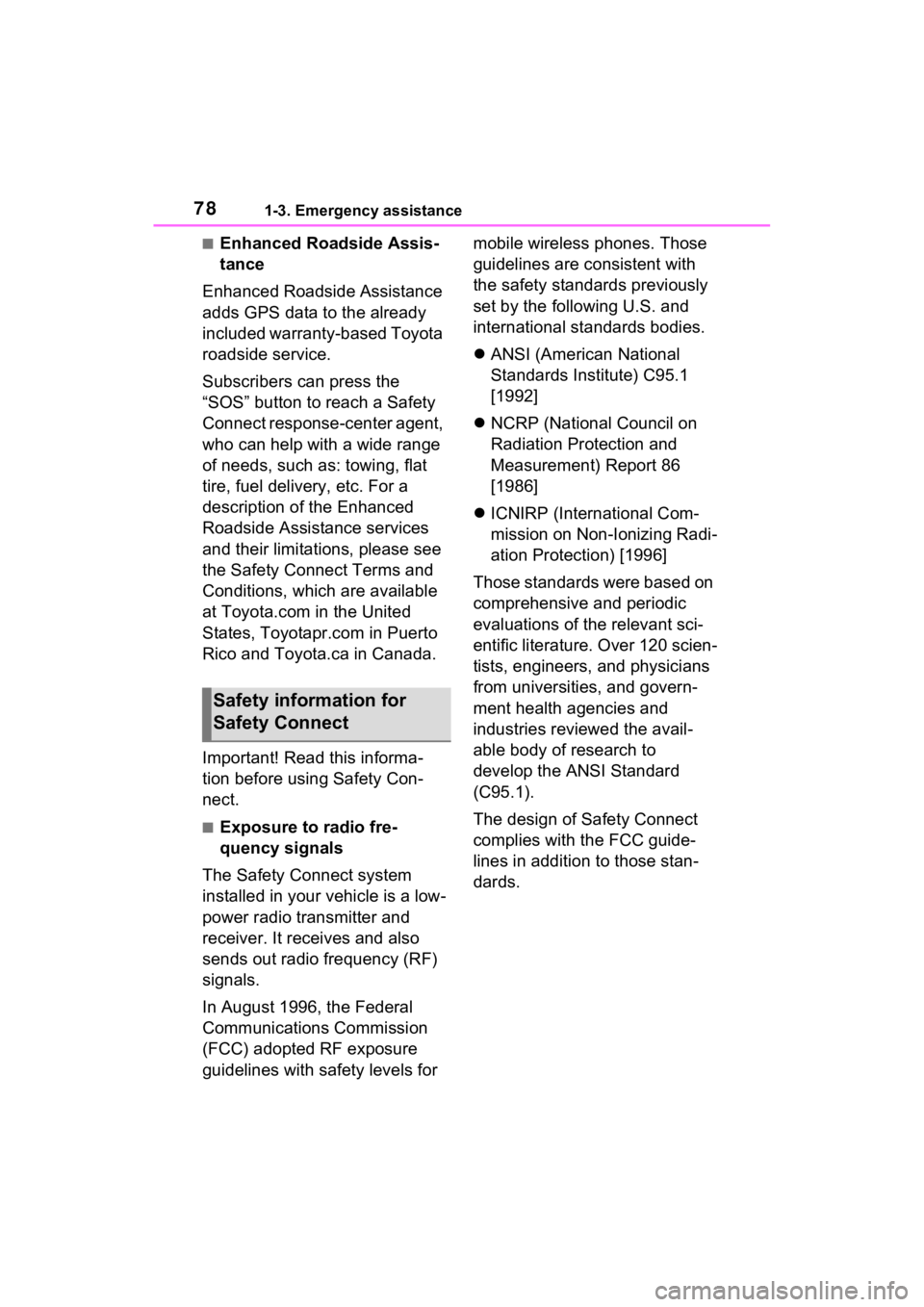
781-3. Emergency assistance
■Enhanced Roadside Assis-
tance
Enhanced Roadside Assistance
adds GPS data to the already
included warranty-based Toyota
roadside service.
Subscribers can press the
“SOS” button to reach a Safety
Connect response-center agent,
who can help with a wide range
of needs, such as: towing, flat
tire, fuel delivery, etc. For a
description of the Enhanced
Roadside Assistance services
and their limitations, please see
the Safety Connect Terms and
Conditions, which are available
at Toyota.com in the United
States, Toyotapr.com in Puerto
Rico and Toyota.ca in Canada.
Important! Read this informa-
tion before using Safety Con-
nect.
■Exposure to radio fre-
quency signals
The Safety Connect system
installed in your vehicle is a low-
power radio transmitter and
receiver. It receives and also
sends out radio frequency (RF)
signals.
In August 1996, the Federal
Communications Commission
(FCC) adopted RF exposure
guidelines with safety levels for mobile wireless phones. Those
guidelines are consistent with
the safety standards previously
set by the following U.S. and
international standards bodies.
ANSI (American National
Standards Institute) C95.1
[1992]
NCRP (National Council on
Radiation Protection and
Measurement) Report 86
[1986]
ICNIRP (International Com-
mission on Non-Ionizing Radi-
ation Protection) [1996]
Those standards were based on
comprehensive and periodic
evaluations of the relevant sci-
entific literature. Over 120 scien-
tists, engineers, and physicians
from universities, and govern-
ment health agencies and
industries reviewed the avail-
able body of research to
develop the ANSI Standard
(C95.1).
The design of Safety Connect
complies with the FCC guide-
lines in addition to those stan-
dards.
Safety information for
Safety Connect
Page 79 of 601
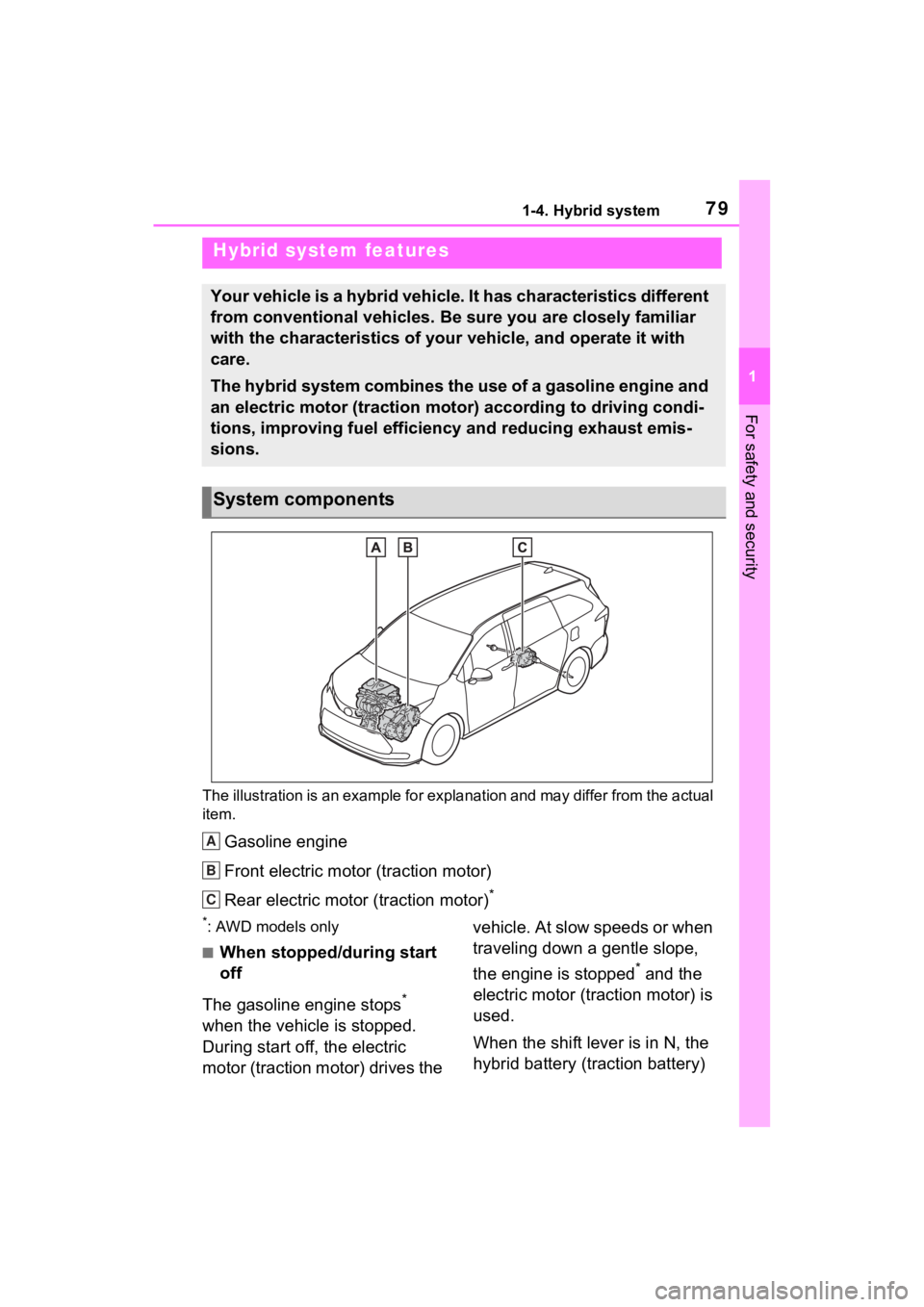
791-4. Hybrid system
1
For safety and security
1-4.Hybrid system
The illustration is an example for explanation and may differ from the actual
item.
Gasoline engine
Front electric motor (traction motor)
Rear electric motor (traction motor)
*
*: AWD models only
■When stopped/during start
off
The gasoline engine stops
*
when the vehicle is stopped.
During start off, the electric
motor (traction motor) drives the vehicle. At slow speeds or when
traveling down a gentle slope,
the engine is stopped
* and the
electric motor (traction motor) is
used.
When the shift lever is in N, the
hybrid battery (traction battery)
Hybrid system features
Your vehicle is a hybrid vehicle. It has characteristics differ ent
from conventional vehicles. Be sure you are closely familiar
with the characteristics of your vehicle, and operate it with
care.
The hybrid system combines the use of a gasoline engine and
an electric motor (traction motor) according to driving condi-
tions, improving fuel efficiency and reducing exhaust emis-
sions.
System components
A
B
C
Page 80 of 601
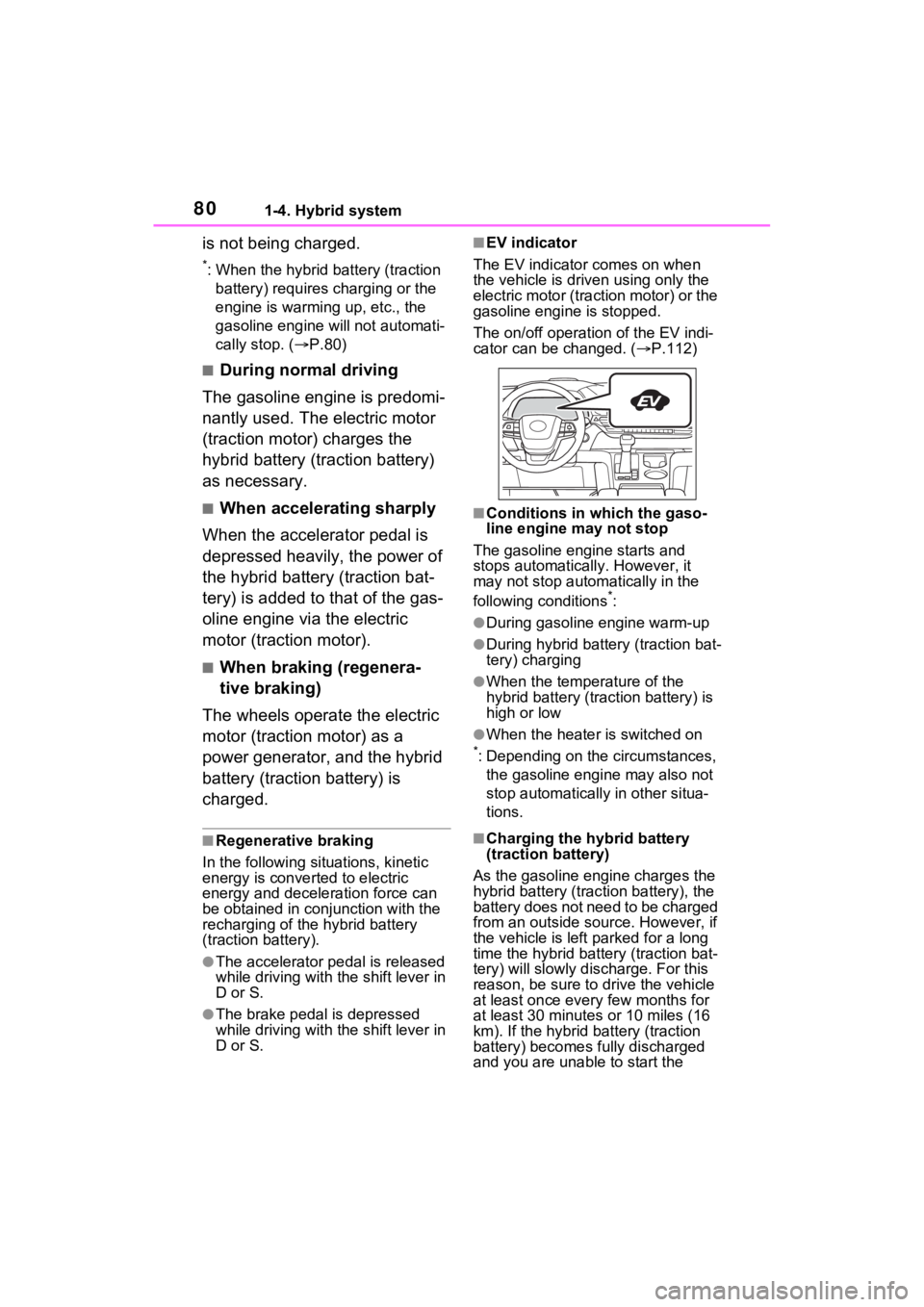
801-4. Hybrid system
is not being charged.
*: When the hybrid battery (traction battery) requires charging or the
engine is warming up, etc., the
gasoline engine will not automati-
cally stop. ( P.80)
■During normal driving
The gasoline engine is predomi-
nantly used. The electric motor
(traction motor) charges the
hybrid battery (traction battery)
as necessary.
■When accelerating sharply
When the accelerator pedal is
depressed heavily, the power of
the hybrid battery (traction bat-
tery) is added to that of the gas-
oline engine via the electric
motor (traction motor).
■When braking (regenera-
tive braking)
The wheels operate the electric
motor (traction motor) as a
power generator, and the hybrid
battery (traction battery) is
charged.
■Regenerative braking
In the following si tuations, kinetic
energy is converted to electric
energy and deceleration force can
be obtained in conjunction with the
recharging of the hybrid battery
(traction battery).
●The accelerator pedal is released
while driving with the shift lever in
D or S.
●The brake pedal is depressed
while driving with the shift lever in
D or S.
■EV indicator
The EV indicator comes on when
the vehicle is driven using only the
electric motor (traction motor) or the
gasoline engine is stopped.
The on/off operation of the EV indi-
cator can be changed. ( P.112)
■Conditions in which the gaso-
line engine may not stop
The gasoline engine starts and
stops automatically. However, it
may not stop automatically in the
following conditions
*:
●During gasoline engine warm-up
●During hybrid battery (traction bat-
tery) charging
●When the temperature of the
hybrid battery (traction battery) is
high or low
●When the heater is switched on*: Depending on the circumstances, the gasoline engine may also not
stop automatically in other situa-
tions.
■Charging the hybrid battery
(traction battery)
As the gasoline engine charges the
hybrid battery (trac tion battery), the
battery does not need to be charged
from an outside source. However, if
the vehicle is left parked for a long
time the hybrid battery (traction bat-
tery) will slowly dis charge. For this
reason, be sure to drive the vehicle
at least once every few months for
at least 30 minutes or 10 miles (16
km). If the hybrid battery (traction
battery) becomes fully discharged
and you are unabl e to start the
Page 81 of 601
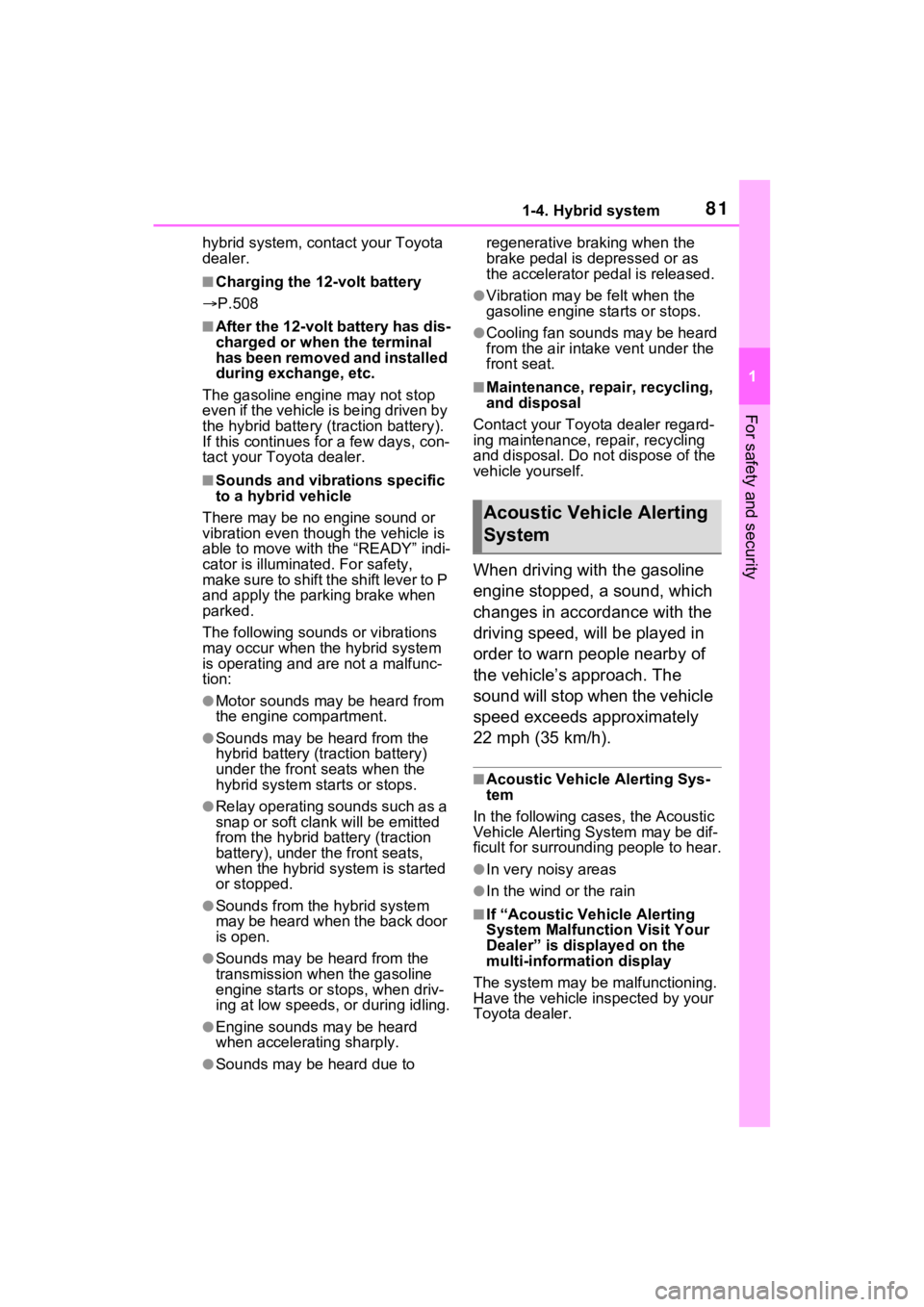
811-4. Hybrid system
1
For safety and security
hybrid system, contact your Toyota
dealer.
■Charging the 12-volt battery
P.508
■After the 12-volt battery has dis-
charged or when the terminal
has been removed and installed
during exchange, etc.
The gasoline engine may not stop
even if the vehicle is being driven by
the hybrid battery (traction battery).
If this continues for a few days, con-
tact your To yota dealer.
■Sounds and vibrations specific
to a hybrid vehicle
There may be no engine sound or
vibration even though the vehicle is
able to move with the “READY” indi-
cator is illuminate d. For safety,
make sure to shift the shift lever to P
and apply the parking brake when
parked.
The following sounds or vibrations
may occur when the hybrid system
is operating and are not a malfunc-
tion:
●Motor sounds may be heard from
the engine compartment.
●Sounds may be heard from the
hybrid battery (traction battery)
under the front seats when the
hybrid system starts or stops.
●Relay operating sounds such as a
snap or soft clank will be emitted
from the hybrid battery (traction
battery), under the front seats,
when the hybrid system is started
or stopped.
●Sounds from the hybrid system
may be heard when the back door
is open.
●Sounds may be heard from the
transmission when the gasoline
engine starts or stops, when driv-
ing at low speeds, or during idling.
●Engine sounds may be heard
when accelerating sharply.
●Sounds may be heard due to regenerative braking when the
brake pedal is depressed or as
the accelerator pedal is released.
●Vibration may be felt when the
gasoline engine starts or stops.
●Cooling fan sounds may be heard
from the air intake vent under the
front seat.
■Maintenance, repair, recycling,
and disposal
Contact your Toyota dealer regard-
ing maintenance, repair, recycling
and disposal. Do n ot dispose of the
vehicle yourself.
When driving with the gasoline
engine stopped, a sound, which
changes in accordance with the
driving speed, will be played in
order to warn people nearby of
the vehicle’s approach. The
sound will stop when the vehicle
speed exceeds approximately
22 mph (35 km/h).
■Acoustic Vehicle Alerting Sys-
tem
In the following cases, the Acoustic
Vehicle Alerting System may be dif-
ficult for surrounding people to hear.
●In very noisy areas
●In the wind or the rain
■If “Acoustic Vehicle Alerting
System Malfunction Visit Your
Dealer” is displayed on the
multi-information display
The system may be malfunctioning.
Have the vehicle inspected by your
Toyota dealer.
Acoustic Vehicle Alerting
System